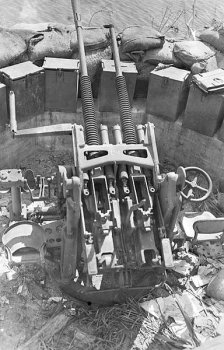![]() The Pacific War Online Encyclopedia
The Pacific War Online Encyclopedia
|
| Previous: Japanese 20mm Type 99 Cannon | Table of Contents | Next: Japanese 30mm Ho-155 Cannon |

National Archives #80-G-281189.
| Bore |
25mm 0.984" |
| Ammunition type |
AP fixed shell. Contact fused HE, HE tracer, and HE incendiary were also available. |
|
Projectile weight |
0.55 lbs 0.25 kg |
|
Velocity |
2953 feet per second 900 meters per second |
|
Maximum elevation |
85 degrees |
|
Range |
8200 yards 7500 meters |
|
Altitude |
18,040 feet 5500 meters |
|
Rate of fire |
230 rounds per minute |
| Production |
33,000 guns on 20,000 mounts |
| Loadout |
Typically 2700 rounds per gun |
The Type 96 was a derivative of the French Hotchkiss, which was an antitank gun redesigned for the antiaircraft role. It was the standard Japanese light antiaircraft gun at the start of the war. It used a gas-operated action and included many stainless steel parts so that it could be used on submarines. Castings replaced some of the machined parts of the original design, probably to reduce manufacturing costs. The gun was air-cooled and the cooling fins provided extra strength to the breech end of the barrel. Single mounts were free-swinging, while double and triple mounts were manual gear driven, except for shipboard triple mounts that had remote power control from their Type 95 directors.
The original Hotchkiss dated to 1930 and the Type 96
entered service on 19 June 1935. Rheinmettal engineers made some
slight improvements that were adopted on 6 August 1936, the same
date that the twin mount entered service.
Unfortunately for the Japanese, the Type 96 was a mediocre weapon, with much too slow a traverse rate (just 18 degrees per second for the twin mount), and with a clumsy ammunition feed system using 15-round drums that greatly reduced the effective rate of fire. Fire control was also poor, often consisting of nothing more than an open ring sight, though most triple mounts were equipped with the Type 95 director. The gas cylinder connections meant that changing a barrel took over five minutes for two men. It was possible for worn guns to spontaneously fire when a new magazine was slammed into place. Gun shields were provided only on Yamato, where they served as blast shields against the ship's own 18" guns.
The 1.1"/75
light antiaircraft gun with which the U.S. Navy began the war
was
also seriously flawed, but it was rapidly replaced with the much
superior 20mm
Oerlikon.
The Japanese never developed a replacement for the 25mm/60 in
the light antiaircraft role, nor did they develop a medium
antiaircraft gun comparable to the 40mm Bofors.
Instead, they convinced themselves that the Type 96 was an
excellent weapon, and they relied on it to the end of the war.
 |
 |
 |
 |
References
NavWeaps.org (2009-3-4; accessed 2014-12-13)
The Pacific War Online Encyclopedia © 2007, 2009-2010, 2014, 2016 by Kent G. Budge. Index